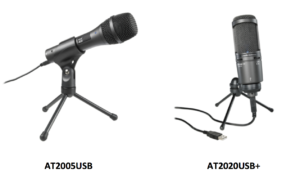Question: I have a new USB microphone. What do I need to know?
Answer: You are so excited! You opened that package with the big red bow and found this wonderful Audio-Technica AT2020USB+ microphone inside. Or maybe you received an ATR2500-USB or one of Audio-Technica’s other USB mics. Great! Now you ask yourself, “Is there anything special I need to know about a USB mic?” Absolutely. Let us share just a few important things that will help you get the most out of your new microphone.
 The very first thing you need to know is the difference between a regular microphone and a USB microphone. Without getting into a lot of technical explanations, think of a regular microphone as an analog device and a USB microphone as one that has a built-in analog-to-digital converter (A-to-D converter). Why is this important? An analog microphone is mainly used to provide live sound reinforcement into a public address system or an audio/video conferencing system. An analog microphone can also be used for recording audio into a computer system, but you need additional (expensive) equipment to convert the analog audio signal into a digital format that computer programs can understand. A USB microphone has the analog-to-digital converter built in, so all you need to do is plug the microphone into your computer and fire up your recording or communication software.
The very first thing you need to know is the difference between a regular microphone and a USB microphone. Without getting into a lot of technical explanations, think of a regular microphone as an analog device and a USB microphone as one that has a built-in analog-to-digital converter (A-to-D converter). Why is this important? An analog microphone is mainly used to provide live sound reinforcement into a public address system or an audio/video conferencing system. An analog microphone can also be used for recording audio into a computer system, but you need additional (expensive) equipment to convert the analog audio signal into a digital format that computer programs can understand. A USB microphone has the analog-to-digital converter built in, so all you need to do is plug the microphone into your computer and fire up your recording or communication software.
The second thing you need to know is that your USB microphone works with a device driver on your computer. A device driver is software that tells your operating system how to communicate with a device connected to the computer. For Audio-Technica’s USB microphones, no special drivers are necessary. Instead, the microphones use the USB audio codec that is a standard part of the Windows and Mac operating systems. (For additional information see our previous blog post about USB drivers.)
The third thing you need to know, as you think about how you might want to use your new mic, is that USB microphones are quite versatile. As the old adage says, “the sky’s the limit.” For those wanting to engage in home recording without spending a fortune on recording equipment, a USB microphone may be just what you want. For those who publish video blogs or podcasts, a USB mic may be perfect. Creating video training or documentation is another great opportunity for using a USB mic. Many folks use a USB microphone to improve the audio quality of their Skype sessions. One great advantage to a USB microphone is that you can throw the mic in your computer bag or case and record or communicate just about anywhere without taking a lot of bulky equipment with you.
On final thing you need to know about a USB microphone is the number of mics you can use at the same time. With a Windows operating system, only one USB mic can be used at a time. With a Mac, it is possible to use multiple USB mics at the same time, but that takes some special configuration to do (which just may be a subject for a future post).
If you have additional questions or would like a recommendation for an Audio-Technica USB microphone, feel free to contact the Audio-Technica Audio Solutions Department. We are always happy to help.
















































































































































.webp)































